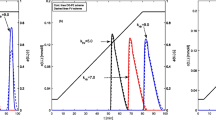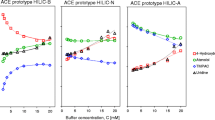Abstract
Optimal operation in chromatography is needed to save operation time and the solvent used in multiple chromatographic runs. To this end, many simulation studies of chromatography process have been performed. The relationship between the distribution coefficient and the ionic strength is important in gradient elution ion chromatography. Experimental runs and computer simulation were carried out under linear gradient elution conditions in order to compare the experiments and the simulation. Experiments were performed with formic acid under isocratic conditions to determine the simulation equation parameters. Computer simulation was based on three equations which related distribution with ionic strength as follows;K=αI −β, K=A+BI+Cl2 and\(K = \gamma _0 + A_1 \cdot e^{( - I/m_1 )} \cdot e^{( - I/m_2 )} \). The effects of gradient slope on the chromatograms are discussed, and good agreement between the experimental and the simulated results is shown.
Similar content being viewed by others
References
Robert, G. L. and T. H. James (1997) Rate Parameters and gradient correlations for gradient-Elution chromatography.AIChE J. 43: 464–474.
Roy, D. R., P. A. Christopher, and S. A. James (1987) Gradient elution in ion chromatography.J. Chromatogr A411: 107–119.
Yamamoto, S., K. Nakanishi, R. Matsuno, and T. Kamikubo (1983) Ion exchange chromatography of proteins.Biotechnol. Bioeng. 25: 1465–1483.
Firoz, D. and H. Csaba (1989) Gradient elution in nonlinear preparative liquid chromatography.J. Chromatogr. 484: 1–27.
Billy, K. and V. Ajoy (1998) Preparative gradient elution chromatography of chemotactic Peptides.J. Chromatogr. A796: 195–209.
Jhon, S. B., G. M. Paul, C. W. David, and V. Marcio (1997) Applying chromatography simulation to scale up from analytical scale experimentals.Technical Report of Schering-Plough Research Institute. 1101 Morris Avenue, Union, NJ, USA.
Oliver, K. and J. Alois (1996) Adsorption isotherms in protein chromatography combined influence of protein and salt concentration on adsorption isotherm.J. Chromatogr. A734: 183–194.
Martin, C. and G. Guiochon (1990) The physical sense of simulation models of liquid chromatography: propagation through a grid or solution of the mass balance equation?Anal. Chem. 62: 189–200.
Zoubair, M., E. Fallah, and G. Guiochon (1991) Cradient elution chromatography at very high column loading: Effect of the deviation from the Langmuir model on the band profile of a single component.Anal. Chem. 63: 2244–2252.
Dorota, A., W. Pia, and K. Kaczmarski (2000) Determination of mobile phase effect on single-component adsorption isotherm by use of numerical estimation.J. Chromatogr. A874: 1–12.
Kim, I. H., S. M. Lee, and W. S Whang (1999) Simulation of preparative protein chromatography.Kor. J. Biotechnol. Bioeng. 14: 371–376.
Sadroddin, G. S., and G. Guiochon (1994) Modeling of preparative liquid chromatography.J. Chromatogr. A658: 149–171.
Row, K. H. (1999) Principles and Applications of Liquid Chromatography. Inha University Press. p. 149–174.
Lee, J. W. and K. H. Row (1997) Comparison and estimation of equilibrium constants for deoxyribonucleosides by plate theory and moment method.J. Kor. Ind. Eng. Chemistry. 8: 403–409.
Takaharu, S., N. Kozo, and Y. Toshimasa (1985) Characterization of cation exchange resins as to separation of glucose and fructose using the moment analysis technique.Agric. Biol. Chem. 49: 2619–2625.
Macsyma Inc. (1996) PDEase2DTM Reference Manual. Arlington, MA, USA.
Author information
Authors and Affiliations
Corresponding author
Rights and permissions
About this article
Cite this article
Won, HJ., Kim, IH. Prediction of formic acid chromatogram in gradient elution chromatography. Biotechnol. Bioprocess Eng. 6, 31–36 (2001). https://doi.org/10.1007/BF02942247
Received:
Accepted:
Issue Date:
DOI: https://doi.org/10.1007/BF02942247




